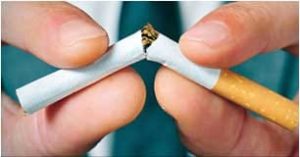Toxins from Third Hand Smoke Are Dangerous
Third Hand Smoke: Who Knew?
Recently, several news outlets have reported a new health danger from cigarettes—third-hand smoke. Third-hand smoke is the residual noxious brew of gases and particles clinging to hair, clothing, furniture and floors long after visible secondhand smoke has cleared a room. Reading like a who’s–who list of bad guys, the toxins include hydrogen cyanide (used in chemical weapons), carbon monoxide (found in car exhaust), butane (used in lighter fluid), ammonia (used in household cleaners), toluene (found in paint thinners), arsenic (used in pesticides), lead (formerly found in paint), chromium (used to make steel), cadmium (used to make batteries), and polonium–210 (a highly radioactive carcinogen).

Small children are especially susceptible to third-hand smoke exposure. Low levels of tobacco particulates have been associated with cognitive deficits among children, similar to low–level exposure to lead. Findings include evidence that the higher the exposure level, the lower the reading score, underscoring the possibility that even extremely low levels of these compounds may be neurotoxic.
Strike One: Tobacco Industry’s Responses to Studies Highlighting Smoking’s Link to Lung Cancer
Missing from these news reports are responses from the tobacco industry. If history is any indication, the tobacco industry will not readily agree to the dangers posed by third hand smoke. For instance, when studies from medical research began to leak into popular press noting the link between smoking and lung cancer in the 1950s, the tobacco industry “launched a massive public relations campaign—to discredit and distort the truth about smoking and cancer, to deny any link between smoking and serious illness, and to persuade the public that ‘there is no proof that cigarette smoking is a cause of lung cancer’—the underlying purpose of which was ‘reassurance of the public.’” (Whiteley v. Philip Morris, Inc. (2004)117 Cal.App.4th 635, 679-682)
By 1964, the first U.S. Surgeon General report on the link between smoking and cancer was published, followed by additional reports and supplements in the decades following. Nevertheless, decade after decade, the tobacco industry disputed it had been proved that smoking caused lung cancer. Still, as knowledge of the dangers of smoking (and later, secondhand smoke) grew, public policy shifts led to advertising restrictions and public smoking bans. In return, the overall number of American men and women who smoke has declined. [Tobacco Timeline: U.S. Smoking Rates Since 1965] This is good news.
Strike Two: Tobacco Industry’s Responses to Studies Linking Smoking to Increased Risk of Disease
The bad news—the same tactics used to refute the dangers of smoking have been repeated in response to scientific findings regarding the dangers of secondhand smoke. Secondhand smoke, also known as “environmental tobacco smoke” (ETS) or “passive smoking,” is a mixture of two forms of smoke from burning tobacco products: “sidestream smoke” and “mainstream smoke.” Sidestream smoke is the smoke coming off the end of a smoldering cigarette. Mainstream smoke is a combination of inhaled and exhaled smoke from a smoker. The tar derived from secondhand smoke is three times more toxic per gram and two to six times more tumourigenic per gram than the tar produced by mainstream smoke when applied to the skin.
Babies exposed to secondhand smoke are two times more likely to die of SIDS. Secondhand smoke is associated with 7,500 to 15,000 hospitalizations of infants and toddlers annually, leads to 136 to 212 deaths in children 18 months of age or younger, and contributes to 8,000 to 26,000 new cases of asthma in children each year. Not only harmful to children, but the California Environmental Protection Agency also estimates that secondhand smoke exposure causes approximately 3,400 lung cancer deaths and 22,700–69,600 heart disease deaths annually among adult nonsmokers in the United States.
Given the staggering health implications associated with secondhand smoke, restrictions on public smoking have been gaining ground over the last two decades, and California has been a leader. For instance, Berkeley, CA, was the first city in the nation to legislate smoking sections in restaurants, and California was the first state to ban smoking in bars. Both policies, while controversial at inception, established a blueprint being adopted both nationally and internationally. Recently, San Francisco broke new ground by banning the sale of tobacco products in corporate pharmacies. Not surprisingly, Walgreens and Philip Morris challenged this ordinance, fearing the adoption of similar bans throughout the nation.
As with the initial reports linking smoking with lung cancer, the tobacco industry launched various initiatives to stymie the impact of research linking secondhand smoke to disease. For instance, in 1993, Philip Morris initiated “Project Brass” in response to the U.S. Environmental Protection Agency’s classification of secondhand tobacco smoke as a Group A Human Carcinogen. Project Brass strategies included 1) broadening the secondhand smoke issue to encompass total indoor air quality (i.e., deflecting attention away from secondhand smoke); 2) using “credible third parties” to fight public health measures, and 3) manufacturing doubt about the EPA secondhand smoke report.
Also noteworthy is the Whitecoat Project, the Philip Morris–led global effort to “resist and roll back smoking restrictions” by creating and maintaining controversy about the health effects of secondhand smoke by generating a body of scientific literature supporting the industry’s view that secondhand smoke is not harmful. Philip Morris also started the Accommodation Program which advocated the use of separate smoking and non–smoking sections in public venues as a “reasonable” alternative to legislated smoking restrictions. The Accommodation Program also provided Philip Morris with access to a pool of hospitality business owners and associations to act as credible third party allies in fighting smoking restrictions.
Strike Three: Philip Morris’ Spin—Third-Hand Smoke Dangers to Health Only a ‘Rumor’
Over ten years ago, Philip Morris executives recognized a potential health problem with third hand smoke. A 1998 email from Liz Culley, senior director of corporate affairs for Philip Morris, to a marketing consultant regarding suitable, legally–protected language for the Chairman’s Annual Shareholder Briefing Book offers insight into the tobacco manufacturer’s profits over public health priorities. In a question and answer format, this five-page document sets forth Philip Morris’ treatment of third-hand smoke risks as merely “rumor” while touting the virtues of the Accommodation Program and blaming smoking restrictions for cigarette butt litter.
What a shame. We were hoping they had finally grown a conscience.
Other Surgeon General Reports:
- US Department of Health and Human Services. The Health Consequences of Involuntary Exposure to Tobacco Smoke: A Report of the Surgeon General.
- U.S. Department of Health and Human Services. The 2006 Surgeon General’s Report—The Health Consequences of Involuntary Exposure to Tobacco Smoke.
![[your-subject]](https://braytonlawstg.wpenginepowered.com/wp-content/uploads/2024/09/BP-logo-dark.jpg#5341)









